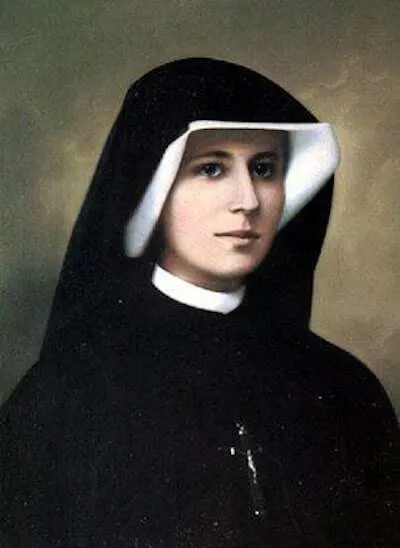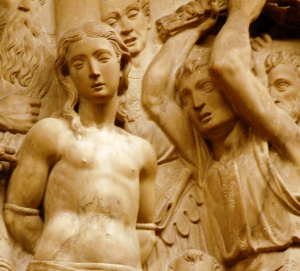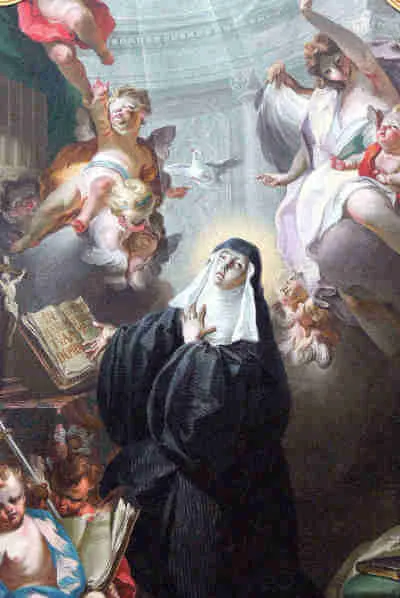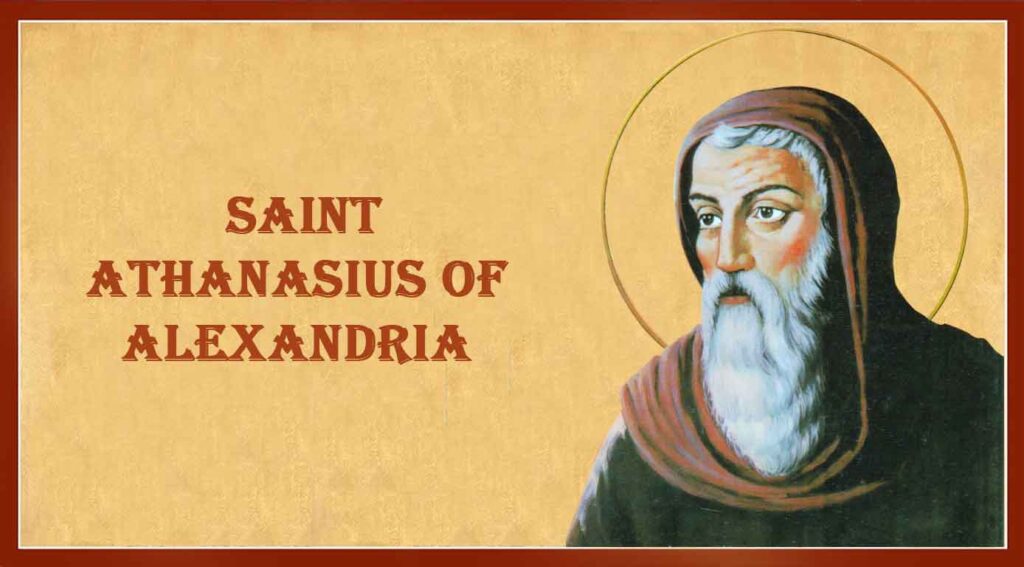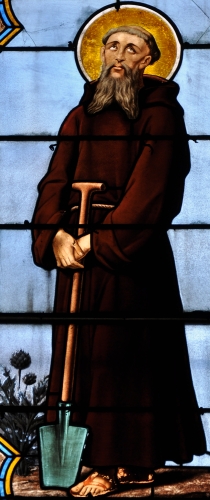1905–1938; Patron Saint of The Divine Mercy devotion; Canonized by Pope John Paul II on April 30, 2000
Helen Kowalska was born the third of ten children in the village of Glogowiec, Poland, which was then under the control of the Russian Empire. Poland regained its independence thirteen years later, in 1918, after World War I. The Kowalskas were quite poor, but they had a rich Catholic faith and held onto their vibrant Polish culture in the face of Russian attempts to eliminate it. As a child, Helen received only three years of schooling but loved to pray, was pious, obeyed her parents, and was sensitive to human suffering. She would later write in her Diary, “From the age of seven, I experienced the definite call of God, the grace of a vocation to the religious life.” At that time, she relates that she first heard God speak to her in her soul and sensed “an invitation to a more perfect life.” When she asked her parents about becoming a nun, they repeatedly refused. At the age of fourteen, Helen left her family home and became a housemaid in the nearby city to help financially support her family. After her parents refused her permission to enter religious life again when she was eighteen, she relates “I turned myself over to the vain things of life, paying no attention to the call of grace, although my soul found no satisfaction in any of these things.” Despite her refusals of grace, Jesus was persistent.
One day, in her eighteenth year, she was at a dance with her sisters. Everyone was having fun at the dance, but Helen was experiencing “deep torments.” As she started to dance, she suddenly had a vision of Jesus at her side—bloodied, beaten, racked with pain, and stripped of His clothing. Jesus said to her, “How long shall I put up with you and how long will you keep putting Me off?” Soon after, Helen sneaked away to the Cathedral of Saint Stanislaus Kostka where she fell prostrate before the Blessed Sacrament and begged God for direction. As she prayed, she heard these words, “Go at once to Warsaw; you will enter a convent there.” She went home, told her sister to say goodbye to her parents, and took the train seventy-five miles to Warsaw with only the dress on her back.
Once Helen got off the train, she prayed to the Mother of God who directed her to a small town where she was given lodging for the night. The next day, while praying in a nearby church, she heard Jesus tell her, “Go to that priest and tell him everything; he will tell you what to do next.” The priest arranged for Helen to stay with a holy woman of the parish for the time. During her brief stay, Helen began knocking on the door of every convent she could find, but they all turned her down. Finally, she knocked on the door of the Congregation of the Sisters of Our Lady of Mercy where the mother superior sent her to the chapel to pray and ask Jesus if He accepted her. Helen then went to the chapel to pose the question to Jesus, and He responded, “I do accept; you are in My Heart.” When Mother Michael asked Helen what Jesus’ response was, Helen told her Jesus accepted her. Mother Michael then responded, “If the Lord has accepted, then I also will accept.” To test Helen’s vocation, Mother Michael sent her away for a year to make some money for her wardrobe. Mother Michael later wrote about this encounter in her diary, stating that Helen “was no one special.” After a year of working as a housemaid near Warsaw, Helen returned to the convent on August 1, 1925, and at the age of twenty was accepted into the Congregation of the Sisters of Our Lady of Mercy. Of that day, she later wrote, “I felt immensely happy; it seemed to me that I had stepped into the life of Paradise. A single prayer was bursting forth from my heart, one of thanksgiving.”
Within a few weeks, however, Helen was frustrated with the convent’s busy schedule and lack of prayer time, so she decided to leave. The night before she was going to tell Mother Michael of her decision, Jesus appeared to her in her cell, beaten and bloody. When she asked Jesus who did this to Him, He responded, “It is you who will cause Me this pain if you leave this convent. It is to this place that I called you and nowhere else; and I have prepared many graces for you.” With that, she changed her mind, went to Krakow to finish her novitiate, and on April 30, 1926, she received the habit and was given the name Sister Maria Faustina of the Blessed Sacrament.
Sister Faustina spent the next twelve years of her life in various convents of the Sisters of Our Lady of Mercy in Warsaw, Vilnius, Płock, and Kraków. It was in Kraków where she died on October 5, 1938, at the age of 33. Throughout her time as a religious sister, Sister Faustina worked primarily as a cook, gardener, and doorkeeper. Her daily duties were intertwined with incredible mystical experiences, in which Jesus regularly appeared to her to deliver to her His message of The Divine Mercy. Under obedience to her superiors, beginning in 1934, she diligently wrote down these visions and private revelations in six notebooks. These private revelations are now contained in a single book called The Diary of Saint Maria Faustina Kowalska: Divine Mercy in My Soul. The book and the devotions contained within it are among the most prominent devotions within the Church today.
In her diary, Saint Faustina articulates several ways that Jesus wants devotion to His Mercy to spread. The first way is by meditating upon the image of Divine Mercy. This image is of Jesus, with two rays of light shining from His Heart, one blue and one red, signifying the Sacraments of Baptism and the Eucharist. Jesus ordered that this image be painted and honored throughout the world, with the inscription “Jesus, I Trust in You” on the bottom. The second way is by instituting the Solemnity of Divine Mercy on the eighth day of Easter. Pope John Paul II added this solemnity to the universal calendar of the Church in the year 2000, when he canonized Saint Faustina. The third way is by praying the Chaplet of Divine Mercy, which Jesus Himself taught to Saint Faustina. The goal of this chaplet is to obtain mercy, trust in Christ’s mercy, and show mercy to others. The fourth way is by honoring the three o’clock hour every day, the hour in which our Lord died and poured forth His Mercy. Finally, Jesus wanted to raise up many apostles of Mercy, who both live mercifully toward others and help spread devotion to His Mercy.
Within two decades after Sister Faustina’s death, the messages of Divine Mercy spread far and wide. Her spiritual director, Father Michael Sopoćko, played a significant role in the initial spread. New religious congregations were founded to spread devotion to Divine Mercy, the image and prayers in the diary extended to other continents, and her diary became exceptionally popular across Poland. Today, the official biography of Saint Faustina, released by the Vatican at the time of her canonization, states, “The years she had spent at the convent were filled with extraordinary gifts, such as: revelations, visions, hidden stigmata, participation in the Passion of the Lord, the gift of bilocation, the reading of human souls, the gift of prophecy, or the rare gift of mystical engagement and marriage.” However, the Vatican actually banned her diary and every devotion attached to it in 1959, stating it had “serious theological reservations” because the diary had “an excessive focus on Faustina herself.” In 1965, then-Cardinal Karol Wojtyła received permission from the Vatican to open an initial informative process into Kowalska’s life and virtues, and submitted his positive findings two years later. However, it wasn’t until 1978, the year that Cardinal Wojtyła was elected Pope John Paul II, that the Vatican lifted its ban on Saint Faustina’s writings, and the process of her canonization was initiated, culminating in her canonization on the eighth day of Easter, 2000, the first universal Church celebration of Divine Mercy Sunday.
For reasons we will only understand in Heaven, God chose this poor, simple, devout, and humble young woman to deliver a message to the world that would become one of the most central and important messages ever delivered. The Divine Mercy of God must be accepted, pondered, lived, and given to others. Mercy is God’s love; it is everything and all things.
As we honor this great saint, ponder the fact that the message God gave to us through her was not for some previous generation; it is for today. Reflect upon your own devotion to The Divine Mercy. Do you pray the Chaplet, venerate the image, honor the three o’clock hour, participate in Divine Mercy Sunday, and seek to spread this sacred devotion as an apostle of Divine Mercy? Know that this is a universal invitation from God; it is an invitation and exhortation given to you. Commit yourself to the truths of Divine Mercy and allow that abundant Mercy to flood your soul.
Source: https://mycatholic.life/saints/saints-of-the-liturgical-year/saint-faustina-kowalska/

